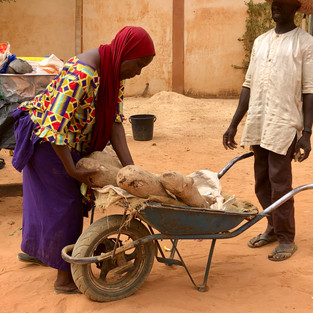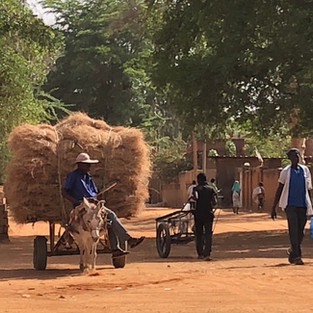Le transport des choses
- dufayjo
- Apr 22, 2021
- 2 min read
Updated: Apr 23, 2021

Niamey's main roads bustle with trucks and cars, many delivering goods. But supplies need to filter into neighbourhoods along sandy streets. Merchandise comes in by a mind boggling range of transport.
Hand carts are the most common. Sometimes they are simple in design, and sell only one product - perhaps from someone's plot by the river.
Watermelons and onions seem to be in season now, and mangos are just hitting thir stride. The earlier sprouting of carrots and Yola (African aubergine) has passed. Manioc root -- as thick as a human thigh - is constantly popular.

Other push carts carry insulated boxes, full of ice and fish, or transport drums of water sold in small quantities to people selling things or working alongside the road. Going through the sand with such weight on two small wheels must be tough going!

The most impressive carts are virtually department stores in themselves. They commonly have flip flops, cell phone accessories, fabric, kids toys, extension cords, toothpaste, cell phone data cards, hair ties, and ... well loads of things.
Sometimes they are simple barrows, but others are towering mobile displays.
Not everything arrives pushed on two wheels, though. The most impressive non-pushed wheel transportations I've seen are:
A motor-lawn mower carried on the back of a bicycle
A white horse, a black horse and two men, standing in the back of a pick-up truck
And this guy, delivering a fridge-freezer on a moped. Looks like he has the fridge contents in a bag on his handlebars, too.

There's a special category of transportation that I very much admire - Things Carried On Heads.
Women do this more often than men, usually transporting bowls or buckets or sacks. Or sometimes sacks in buckets, or buckets in bowls. Men do this too, but also transport commercial goods. (Note mattresses transported on hand cart in one of the pictures!)
And finally in the transportation of goods department, let's hear it for our four-legged friends. Not counting the ones (goats, mostly, or sheep) who transport themselves, under human supervision, along Niamey's streets, big and small, there are many donkey-carts to be seen everywhere, usually pulling a load of firewood or massive stack of hay.

And camels too - usually loaded with a stack of palm-tree matting, which is used here for construction in the way that corrugated iron is used in Europe (temporary structures, huts, sheds, etc), but sometimes fitted out with a saddle and possibly heading into town from the direction of Timbuktu. Yes, really.

The creativity and determination of people here to find ways to make this expanding city work for them is amazing. Despite the obstacles and real hardship, goods are sold, homes are supplied and life goes on.
In sad news, though, two awful events in the past week. A fire in a school in Niamey ripped through temporary classrooms built of those palm-leaf mats - killed 20 pre-school age children. And another attack on a village in the troubled region of Tilaberi took a further 19 lives.






































Very clever theme and great photos! You could write a whole book on pedlars around the world or over the centuries. Makes me nostalgic for West Africa.
Fab post Jo I love the colours too!
Thank you Jo! Very interesting to see that many of the low tech local transport systems are what should be done everywhere. Africa and maybe global south place are well ahead of many (richer) places on this planet. :)